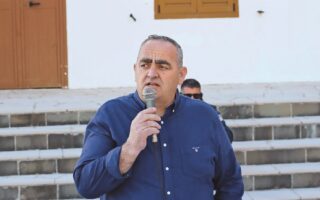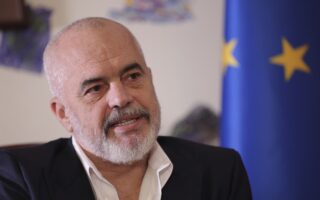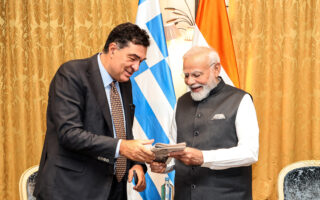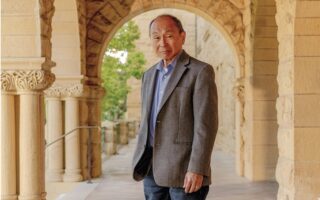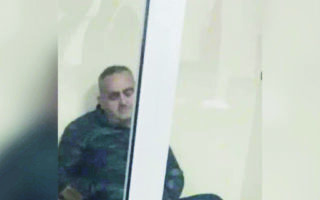Getting a glimpse of the real Oppenheimer
Who was ‘the father of the atomic bomb’ and how has history judged him? The head of the Atomic Heritage Foundation answers the questions
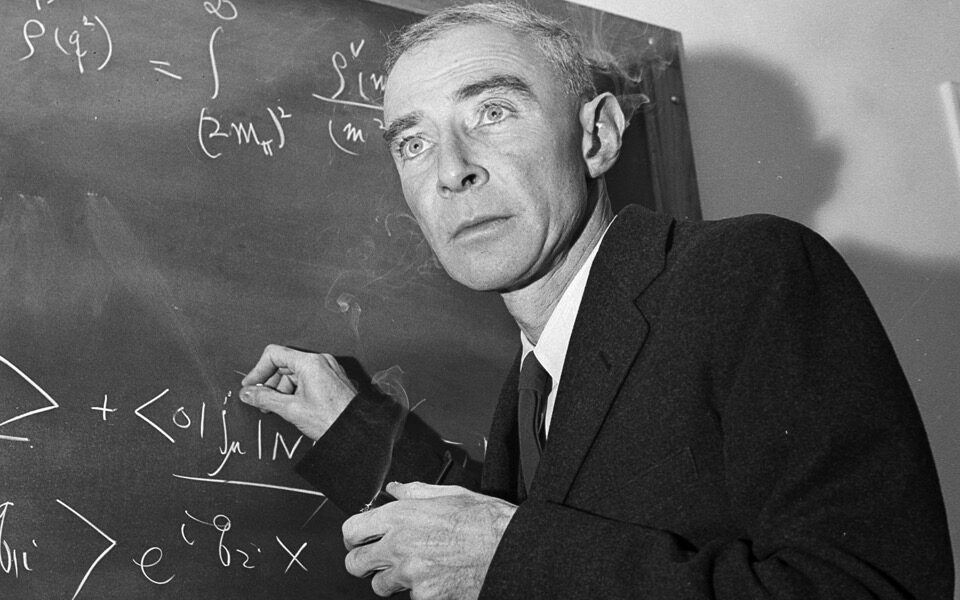
Julius Robert Oppenheimer was a surprising outsider when he took over as director of the Manhattan Project’s Los Alamos Laboratory during World War II. And yet he accomplished the mission that culminated in the dropping of the atomic bomb on Hiroshima, Japan.
Three months after the atomic strike, he tried to convince then-US President Harry Truman of the need for an international ban on nuclear weapons. But it was too late. The bomb had been dropped on Japan and the arms race between the US and the USSR had already begun.
The founder and president of the Atomic Heritage Foundation in Washington, Cynthia Kelly, answers Kathimerini’s questions by discussing Oppenheimer. She describes the conditions that framed the historical events at the end of the Second World War and attempts to assess how high the risk of the nuclear threat is today.
 What was Oppenheimer’s role in shaping US nuclear policy?
What was Oppenheimer’s role in shaping US nuclear policy?
After directing the Los Alamos Laboratory during the Manhattan Project, Oppenheimer became known as the “father of the atomic bomb.” However, Oppenheimer was opposed to the development of the thermonuclear or hydrogen bomb and his role in shaping US nuclear policy was abruptly ended in 1954.
Oppenheimer was chairman of the General Advisory Committee to the Atomic Energy Commission (AEC) which opposed development of the hydrogen bomb in October 1949. Despite the committee’s reservations, Truman authorized development of the hydrogen bomb on March 10, 1950.
The debate over the hydrogen bomb widened the gulf between Oppenheimer and proponents of the hydrogen bomb, including physicists Edward Teller and Luis Alvarez, and AEC Commissioner Lewis Strauss. In 1954, Oppenheimer was successfully banished from nuclear weapons policy deliberations as the Atomic Energy Commission voted 2 to 1 to remove his security clearance. As a result, Oppenheimer no longer had access to classified information about nuclear weapons and could not raise objections to what became the Cold War arms race between the US and USSR.
Oppenheimer argued that a nuclear war was unwinnable. “We may be likened to two scorpions in a bottle, each capable of killing the other, but only at the risk of his own life.” In 1954, the US had around 300 nuclear weapons. By the end of the 20th century, the US arsenal of nuclear weapons was around 30,000, a figure matched by the Soviet Union. A few hundred superweapons were more than enough to wipe out most of the world.
On December 16, 2022, the Department of Energy’s Secretary Jennifer Granholm vacated the Atomic Energy Commission’s decision. As more evidence has come to light, Granholm said the Department of Energy has a “responsibility to correct the historical record and honor Dr Oppenheimer’s profound contributions to our national defense and the scientific enterprise at large.” It is a very long-overdue vindication.
What was he like as a person? What do we know about him?
J. Robert Oppenheimer was a complex, charismatic man. Born in New York City in 1904, J. Robert Oppenheimer was a prodigy, admitted to Harvard at age 16. He was interested in literature and poetry and became fluent in six or seven languages. After Harvard, he earned his PhD in theoretical physics at Gottingen. Teaching at the University of California-Berkeley and California Institute of Technology, Oppenheimer founded the first school of theoretical physics in the United States in the 1930s.
‘Unfortunately, the threat of nuclear confrontation seems to be higher now than any time since the end of the Cold War’
Oppenheimer had a brilliant but restless mind. He had many profound insights but did not focus on any one topic long enough to earn a Nobel Prize. With no Nobel Prize and little management experience, Oppenheimer was not an obvious choice to direct the scientific research laboratory for the Manhattan Project. His nomination was also clouded by his associations with Communist party members, including his wife Kitty and brother Frank, also a physicist.
In September 1942, General Leslie Groves, a United States Army Corps of Engineers officer, became the director of the Manhattan Project. General Groves was a hard-driving dynamo and an excellent judge of people. He recognized Oppenheimer’s extraordinary brilliance and personal ambition as essential to the success of the project and selected him.
As a professor before the war, Oppenheimer could be casually cruel to people who made mistakes or asked a naive question. At Los Alamos, he no longer demeaned others but promoted collegiality and cooperation. Manhattan Project physicist Philip Morrison said no one else could have done what Oppenheimer did, marshaling many difficult personalities to work together. Even his nemesis Edward Teller agreed that Oppenheimer was the finest laboratory director he had ever known.
How was Oppenheimer’s relationship and cooperation with Truman?
J. Robert Oppenheimer did not meet President Harry Truman until October 25, 1945, about six weeks after the war was over. Oppenheimer hoped to persuade President Truman to promote international control of nuclear materials and processes. But Truman did not want to give up the United States’ lead over the Soviet Union in nuclear weapons production.
In fact, Truman told Oppenheimer that he thought that the Soviets would never get an atomic bomb of their own. This indicated to Oppenheimer that the president did not understand that the physics behind the atomic bomb was widely known, and the Soviets could probably produce one in five to 10 years. In fact, the Soviets detonated their first atomic bomb in August 1949, four years later.
When Oppenheimer said he had “blood on his hands,” Truman was incensed, and contradicted him, saying that the blood was on his hands [from the Japanese who died in Hiroshima and Nagasaki]. Afterwards, Truman said that he did not want to see that “cry-baby scientist” again.
As a historian today, how do you evaluate the US decision to detonate the atomic bomb? Under what circumstances did it happen? Could it have been avoided?
After the Trinity Test on July 16, 1945, President Truman knew that the atomic bombs would work. Truman and his advisers thought that dropping the bombs would bring an end to the war without a costly Allied invasion of the Japanese homeland. To pressure Japan to surrender, Truman threatened Japan with “prompt and utter destruction” if they did not.
However, President Truman and his advisers did not appreciate the situation in Japan. While the country was largely defeated and on the verge of starvation, Emperor Hirohito’s admirals and generals refused to surrender even after the dropping of the atomic bomb on Hiroshima. Fanatics in the Japanese Army were organizing a coup. The Big Six, top military and government leaders who advised the emperor, could not reach consensus. The second bomb was dropped on Nagasaki and the Soviets entered the war, invading Manchuria.
Given the precarious situation, Emperor Hirohito breaks the Big Six’s tie vote to accept Allied terms. The Big Six help craft a message which Hirohito records for broadcast to the Japanese people the next day, August 15, 1945.
History is full of “what if” questions. However, it does not seem likely, knowing what we do now, that Emperor Hirohito and his Big Six advisers would have agreed to surrender without the use of the atomic bombs. As Hirohito said in his message to the Japanese people, the atomic bombs were a key factor:
The war situation has developed “not necessarily to Japan’s advantage,” and “the enemy has begun to employ a new and most cruel bomb, the power of which to do damage is indeed incalculable.” If Japan continued to fight, it would “not only result in the ultimate collapse and obliteration of the Japanese nation, but also it would lead to the total extinction of human civilization.”
In your estimation, how at risk is the world today from nuclear war?
Unfortunately, the threat of nuclear confrontation seems to be higher now than any time since the end of the Cold War. With the war in Ukraine, Russia is using rhetoric threatening the use of nuclear weapons. In addition, the Kremlin has announced plans to place non-strategic nuclear weapons in Belarus. The movement of nuclear weapons to Belarus is threatening to not just Ukraine but the entire international community.
Since the 2020 Non-Proliferation Treaty Review Conference, the United States and Russia have been upgrading their nuclear weapons arsenals in the name of “modernization.” In addition, the New START Treaty, the last remaining nuclear weapons treaty between the US and Russia, expires on February 4, 2026.
As of February 2023, Russia is “suspending its participation” in New START. The treaty allows each country to inspect the other country’s nuclear arsenals to verify that the weapons pact is being followed. It also requires regular communications between the two countries to avoid misunderstandings or accidents. Suspending these exchanges increases the risk of an intentional or accidental use of nuclear weapons. All these developments are very worrisome.
